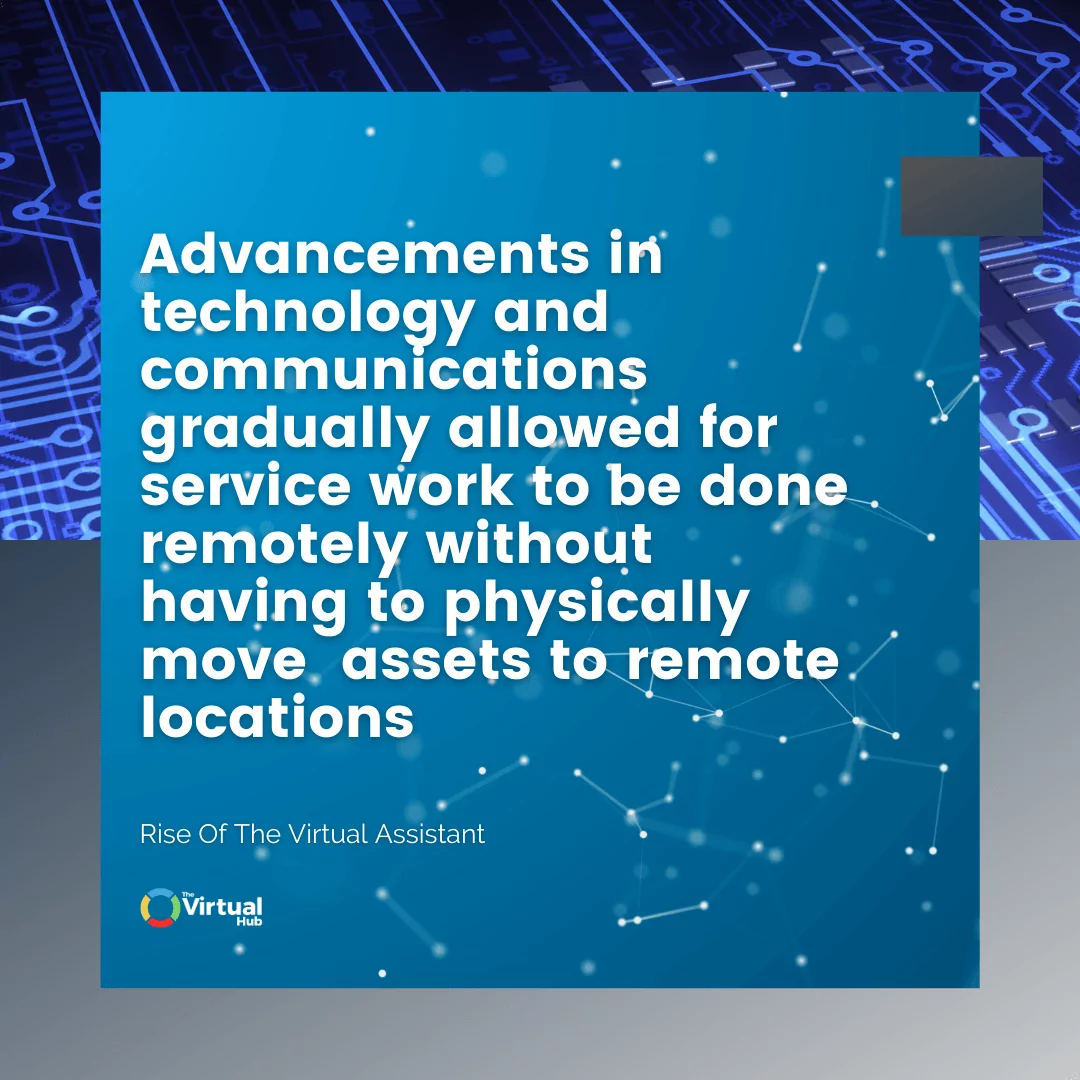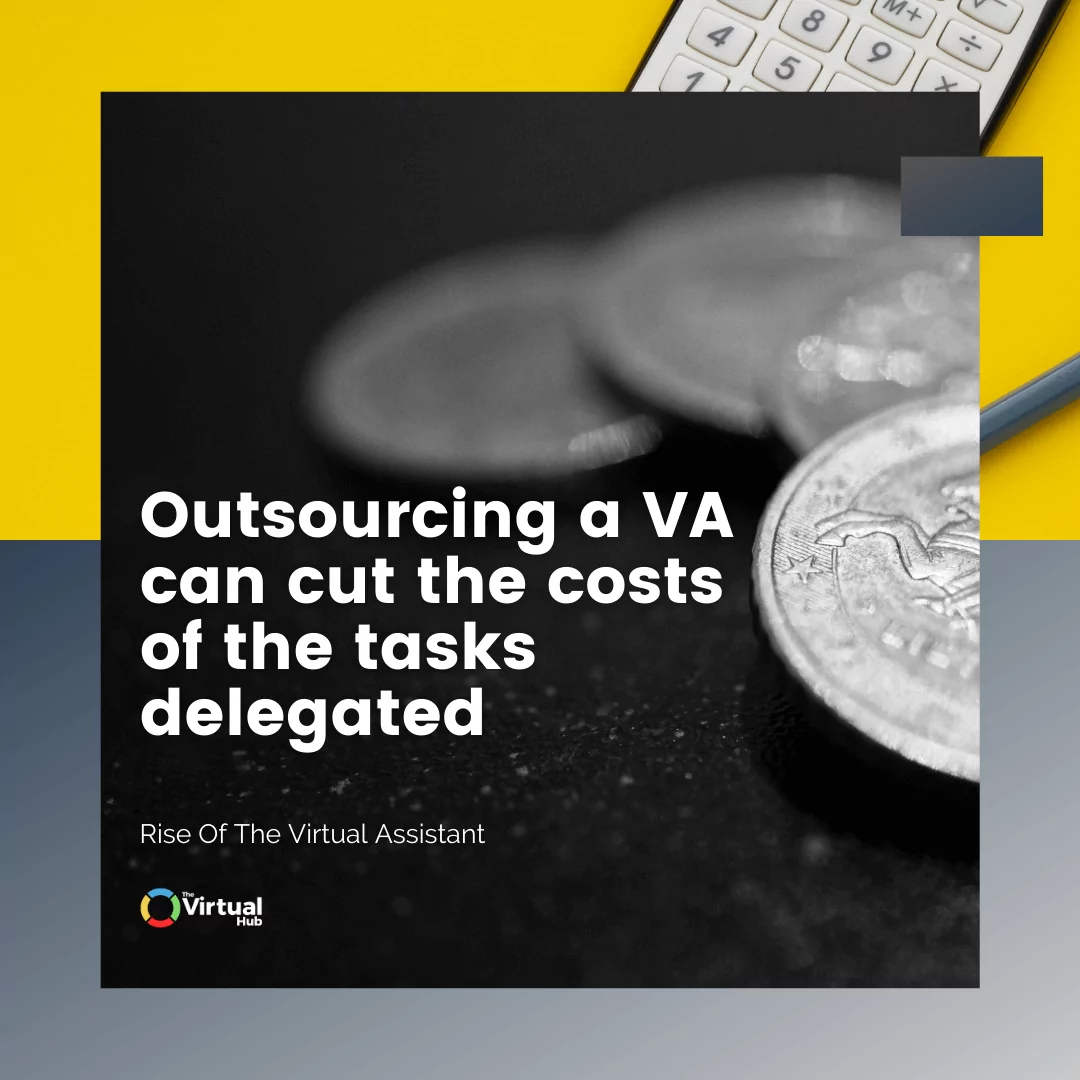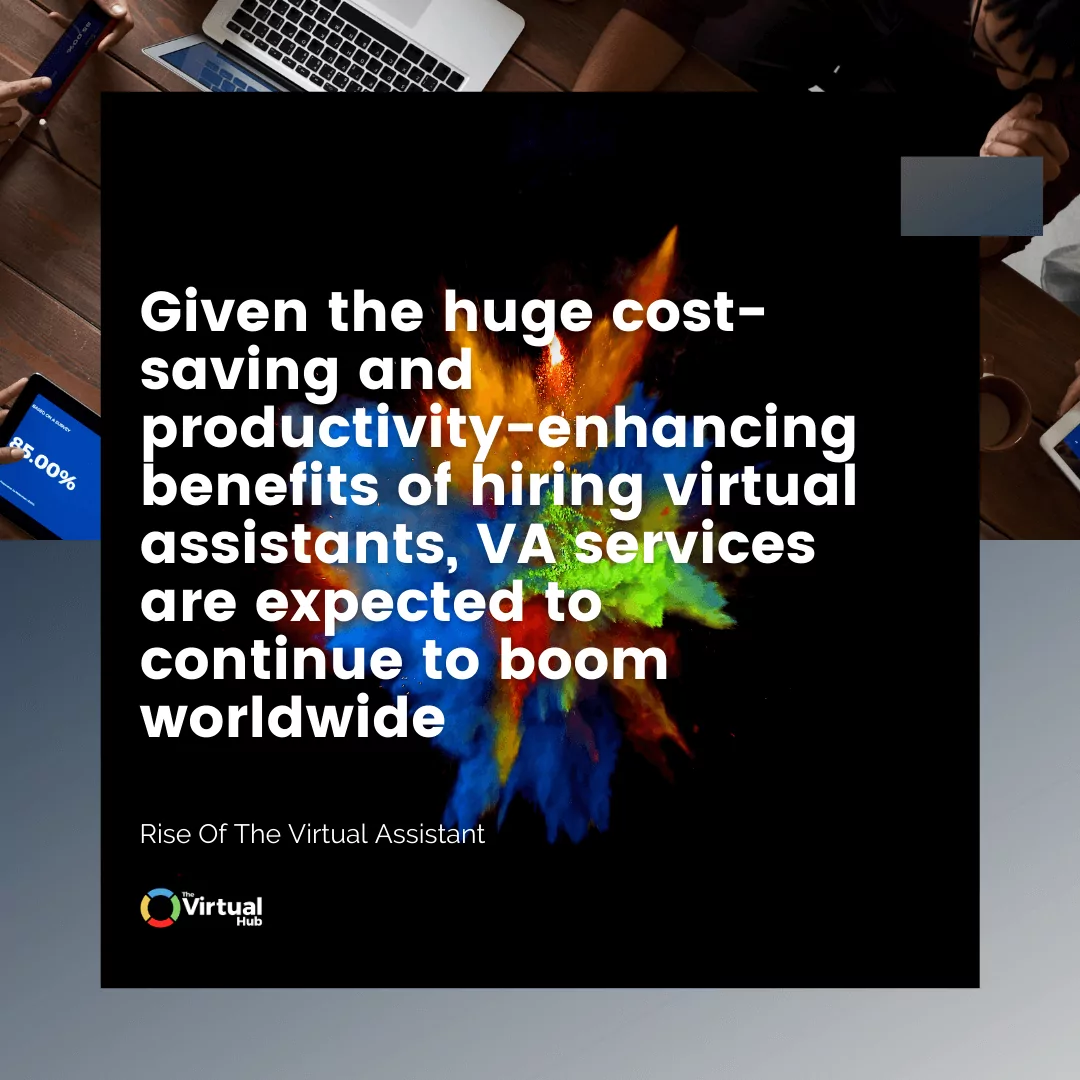Using virtual assistants, or “VAs,” to support and grow a small business is a hot topic these days, especially within the realm of online business owners. In fact, search “virtual assistant” and half a billion results come up!
You may know what a virtual assistant is and why they can be game-changing resources for entrepreneurs. But do you know how long they’ve been around and how quickly their industry is growing?
In this blog post, we'll discuss the rise of the virtual assistant and some reasons why you should consider hiring virtual staff.
RELATED: Qualities And Skills Every Virtual Assistant Needs To Have
The Growth of Virtual Assistant Services
You can click on these links below to jump on a specific section:
- Start with the Basics: The History of Outsourcing
- Outsourcing: The Early Days
- The Next Generation of Outsourcing
- Technology Drives International Business
- Evolution of the Admin Field: Secretaries to Virtual Assistants
- About Offshore Virtual Employees
- The First Steps toward Virtual Admins
- Popularity of Virtual Assistants
- The Virtual Assistant Market
- Difference between a Virtual Assistant and a Personal Assistant
- What a Virtual Assistant Does
- Cost of a Virtual Assistant
- The Changing Role and Variety of Virtual Assistants
- Virtual Assistants Are Here to Stay
Start with the Basics: The History of Outsourcing
When you hire a virtual assistant, you’re doing a specific type of outsourcing.
Outsourcing can be defined as “the strategic use of outside resources to perform activities traditionally handled by internal staff and resources.” Simply put, it’s having non-employees perform a business function that could be done by in-house employees.

Companies choose to outsource parts of their non-core business operations to perform those parts more cost-effectively, more efficiently, or at a higher quality than they could perform it in-house.
When a role or function is outsourced to a country that’s far away from the company’s operations, it’s often referred to as offshore outsourcing.
Onshore and offshore outsourcing grew steadily after World War II, and by the 1970s and 1980s, it was a highly popular strategy among U.S. manufacturers for creating a competitive edge. By outsourcing functions unrelated to their core business, companies could focus more closely on their specific business expertise.
By the 70s, many consumer goods were produced overseas, and the 70s and 80s saw some business services (e.g., bookkeeping) being sent overseas, as well.



For example, companies started shipping–literally–paperwork to other locations for cost-effective processing in the 70s. By the 80s, the paperwork was more often sent by plane than by boat, and dozens of paper processing companies sprang up in the Caribbean, Ireland, and Asia. These types of services were the first examples of what is now often referred to as “business process outsourcing” or BPO.



Outsourcing: The Early Days
With the shift to a more digital economy in the last 20 or more years, outsourcing is also a hot topic–and bit of a buzz word right now–but it’s been associated with manufacturing going all the way back to the Industrial Revolution.
When industries first began outsourcing parts of their operations, transportation and communication didn’t happen at the breakneck speed they do now. So, manufacturers typically outsourced part of their operations to other businesses nearby, often in the same city.
Later, manufacturers outsourced parts of their operations overseas, allowing them to enjoy a large cost savings due to different standards of living in places like Asia and South America.
For example, the Philippines was home to one of the early offshore outsourcing sites for a U.S. manufacturer. It was in the Philippines where Coca Cola established its first international bottler in 1927!



The Next Generation of Outsourcing
Although it had been around for decades, outsourcing wasn’t identified as a business strategy until 1989. During that year, a pivotal moment in outsourcing occurred when Kodak Eastman hired IBM to manage IT for their company.



However, the amount of business services that were outsourced to offshore companies in the 1980s remained insignificant, with an estimated 5,000 offshore service workers in 1986. Today, there are an estimated 800,000 offshore service workers in India alone!
Let’s look at the changes in technology and business practices that account for this explosive growth of offshore outsourcing.
Technology Drives International Business
Advancements in technology and communications gradually allowed for service work to be done remotely without having to physically move documents and other assets to the remote locations.
Customer service via telephone was among the first services to grow rapidly, domestically, and then internationally. The invention and adoption of the toll-free 800 numbers meant that consumers could call manufacturers directly and also allowed companies to centralize customer service requests.
Although transatlantic and transpacific cables made international phone calls possible in the first half of the 20th century, those calls were terribly expensive due to the limitations of the cables. In 1956, only 60 transatlantic phone calls could take place at the same time.
Capacity grew over the next 30 years, but prior to 1988 when the first fiber optic cable was strung across the floor of the Atlantic, the number of phone calls crossing the ocean at any given time remained limited to a few thousand.



The first fiber optic cable increased call capacity to 40,000 simultaneous conversations, then in the 90s, improvements in fiber optic cable allowed them to carry more calls at the same time.
Once these additional and improved cables were in place, the cost of international calls became affordable enough for companies to move their call centers offshore as a cost-saving strategy.
IT professional turned business coach/consultant Frank Holz is credited with establishing the first offshore call center in 1992 when he helped the Accenture group set up a center in the Philippines. Later, in 1999, Jack Welch of GE set up their first international call center in India.
The visibility of Jack Welch and GE brought the business world’s attention to the availability of telecom talent in Asia.



Evolution of the Admin Field: Secretaries to Virtual Assistants
So, what does this have to do with virtual assistants?
Well, as business and industry were growing over the course of the 20th century, it created demand for administrative help. By the 1920s, the administrative assistant–then called “secretarial”–field was growing exponentially.



A significant shift from agriculture to industry drove the need for administrative support around the turn of the 20th century and, until that time, secretaries were predominantly men!
In the early 1900s, there was a growing need to process more paperwork just as more men moved into heavy industry fields (e.g., mining) and as more women both began completing high school and entering the workforce. Add in the invention of the typewriter, and the administrative field began to explode!
Which each new technological advancement (think: copiers, computers, fax machines), people often expected new devices to make admin roles obsolete. But each innovation requires people who know how to use those tools! Therefore, the administrative field continued–and continues–to grow.
About Offshore Virtual Employees
Small businesses have been taking advantage of virtual employee offshore where labor is cheaper while still getting the work they need done.
There are many benefits to hiring an offshore virtual team member:
- Companies can save on office space and equipment costs.
- Virtual employees can work from anywhere in the world, so businesses can hire the best talent regardless of location.
- Virtual team members are often more productive than on-site employees because they can work flexible hours and take advantage of technology.
- Companies can build a dedicated team of global virtual employees to support their business goals.
The First Steps toward Virtual Admins
Hop ahead to 1985 when Ms. Linda Anderson established “Home Secretaries,” a company that allowed women to perform administrative work from their homes rather than in traditional office roles and we have our first U.S. example of remote admin workers.
But it wasn’t until 1992 when Stacey (Anastacia) Brice established her own business, offering travel and admin assistance remotely that the virtual assistant profession really took off.
By 1997, she had established the virtual assistant industry in the U.S. when she created AssistU, an organization that highly trained and provided VAs to businesses.
Popularity of Virtual Assistants
The awareness of and demand for VAs has been rising rapidly since 2009 when Tim Ferriss published his book The 4-Hour Work Week.
Ferris’ favorite productivity hack is delegating the many things we find on our to-do lists that could be completed by someone else.



He’s typically credited for creating a movement where people gain efficiency by outsourcing unpleasant, repetitive, boring, and time-consuming tasks, as well as other to-dos that would be done better by someone with a different skillset.
From the around 1996 through the mid-2000s, a variety of virtual assistant company and professional organizations, as well as freelancer VAs, sprang up all over the world. With around 60% of the world’s population connected to the internet, plus the availability and growth new digital tools for sharing and managing work, individuals and businesses have everything they need to delegate tasks to VAs across towns, across countries, and across oceans.
RELATED: How Your Virtual Assistant Can Help To Manage Your Social Media Campaigns



The Virtual Assistant Market
It’s difficult to get a precise estimate of the number of individuals currently employed as virtual assistants, as current data on administrative professionals doesn’t distinguish between admins working in traditional roles and those working virtually. And although there are a number of professional organizations for VAs, such as The International Virtual Assistants Association and the Virtual Assistant Networking Forum, VAs may not belong to any of these organizations.
At the same time, the number of virtual assistants listed on freelancing platforms varies from 5K to 20+K, depending upon the platform, although many of them likely have listings on multiple platforms.



Calculating the value of virtual personal assistant work worldwide is similarly difficult, but there are clues that suggest the demand for VAs will continue to grow and grow rapidly.
Freelancer.com, possibly the world’s largest platform for freelancers, reported that virtual assistants became the second-fastest growing type of work sought on their site during the third quarter of 2019. Their virtual assistant projects increased to 12,329 in Q3, up from 7,925 in Q3, an increase of over 55%!
Plus, research is revealing how outsourcing to a virtual assistant service can cut the costs of the tasks delegated by up to 80%.
If you’re looking to prove that statistic by comparing the overall hourly cost of hiring a VA (i.e., including savings on physical workspace, office equipment, benefits, etc.) to the cost of doing the work in-house by the simple division, you won’t be convinced. But that’s only because the simple math doesn’t account for the increase in the productivity of the in-house employees who will have more time to devote to core business activities.
To clarify what we mean, it’s estimated that low-value, administrative tasks take up to 69 workdays a year for the average employee! That number comes out of an 11-country productivity study conducted by Unit4, a software leader for service-based companies. From those figures, Unit4 estimates that core business productivity lost to admin tasks costs business as much as $5 trillion globally each year!
Therefore, as entrepreneurs and business owners become increasingly aware of both the availability and value of skilled VAs, we have no doubt that more and more businesses will outsource tasks to virtual assistants.






Difference between a Virtual Assistant and a Personal Assistant
The term “personal assistant” is sometimes used interchangeably with “virtual assistant,” but they are not the same.
A personal assistant is an individual who provides direct support to one particular person, usually a high-level executive or business owner. They are often responsible for tasks such as running personal errands.
A virtual assistant, on the other hand, provides administrative, creative, or technical support to multiple clients remotely. In short, a virtual assistant is someone you hire to help with specific tasks that can be accomplished online, whereas a personal assistant is someone you hire to complete tasks that require physical proximity (making travel arrangements, scheduling in-person meetings, etc.).
What a Virtual Assistant Does
Now that we’ve answered the question of what is a virtual assistant and clarified the difference between a virtual assistant and a personal assistant, it’s time to move on to what, exactly, a virtual assistant does.
As we mentioned earlier, the answer to that question is not as simple as it might first appear. Depending on the client’s needs and the VA’s skillset and experience, the tasks assigned to a single virtual assistant can vary widely.
However, there are some general administrative duties that are commonly delegated to VAs. These include (but are certainly not limited to):
- Scheduling appointments and managing calendars
- Booking travel
- Data entry
- Lead generation
- Project management
- Web development
- Email management
- Content writing
- Transcribing video and audio files
- Creating and formatting documents (in Microsoft Office or Google Suite)
- Managing customer relationships (CRM)
- Performing internet research
- Creating PowerPoint presentations
Cost of a Virtual Assistant
The cost of hiring a dedicated assistant can vary depending on a number of factors, including the VA’s experience, skillset, and location.
In general, VAs based in the United States or other Western countries will charge more per hour than those based in Southeast Asia or other regions where the cost of living is lower.
That said, it’s not uncommon for VAs to charge an hourly rate of $10-$20, with rates on the higher end of that range reserved for more experienced or higher-skilled VAs.
Some virtual assistant companies also offer packages that include a certain number of hours per week or month for a flat rate. This pricing model can be beneficial for clients who need a dedicated virtual assistant for a more extended period of time or for recurring and daily tasks.
The Changing Role and Variety of Virtual Assistants



Today, the umbrella term “virtual assistant” refers to individuals with a broad range of skillsets. Yes, many of them perform the strictly admin tasks we’d associate with traditional, in-office administrative assistants. That type of VA is typically referred to as a “general virtual assistant.”
However, rather than coming from traditional admin educational and professional backgrounds, most virtual assistants are college-educated and have work experience across a broad range of business functions.
All VAs typically have extensive training or experience in the digital tools that make virtual work possible, but “specialist” VAs possess additional expertise in specific roles or tools.
At The Virtual Hub, we offer general VA, as well as four categories of specialist VAs: social media management, digital marketing, content management, and systems. But the categories and labels virtual assistants use to describe themselves aren’t limited to those categories.
In fact, the possibilities are practically endless! For example, within social media marketing, there are VAs who have niched down to focus one specific platform, such as LinkedIn or Instagram. VAs might also be specialists with a specific tool like MailChimp for email marketing, Ontraport for building sales funnels, WordPress for publishing content, or Dubsado for creating automated customer workflows.



Graphic design, audio and video editing, and internet research are examples of other areas in which virtual assistants specialize. Specific industries present another opportunity for VAs to specialize. For instance, a VA might focus exclusively on serving photographers or real estate agents.
Virtual Assistants Are Here to Stay
Given the huge cost-saving, the productivity-enhancing benefits of hiring virtual assistants, and our ability to select from talent all over the world to fit our needs and our budgets, we expect virtual assistance services to continue to boom worldwide. And from our point of view, it’s a very good thing for the global market!
At The Virtual Hub, we’re committed to helping entrepreneurs eliminate overwhelm and grow their businesses while providing rewarding, next-level career options for our VAs in the Philippines.
Final Thoughts
As we’ve seen, the role of virtual assistants has changed dramatically since the early days of online work. Once considered a luxury for only the wealthiest entrepreneurs and executives, hiring a VA is now within reach for businesses of all sizes. And with the potential to save businesses time and money, it's no wonder that more and more businesses are looking to outsource to virtual assistants!
